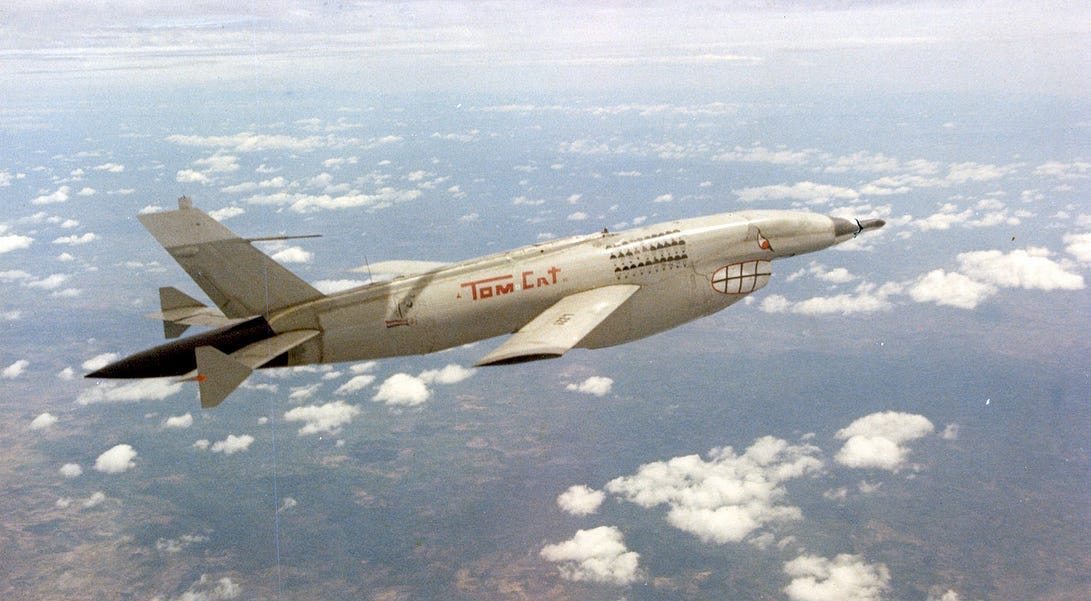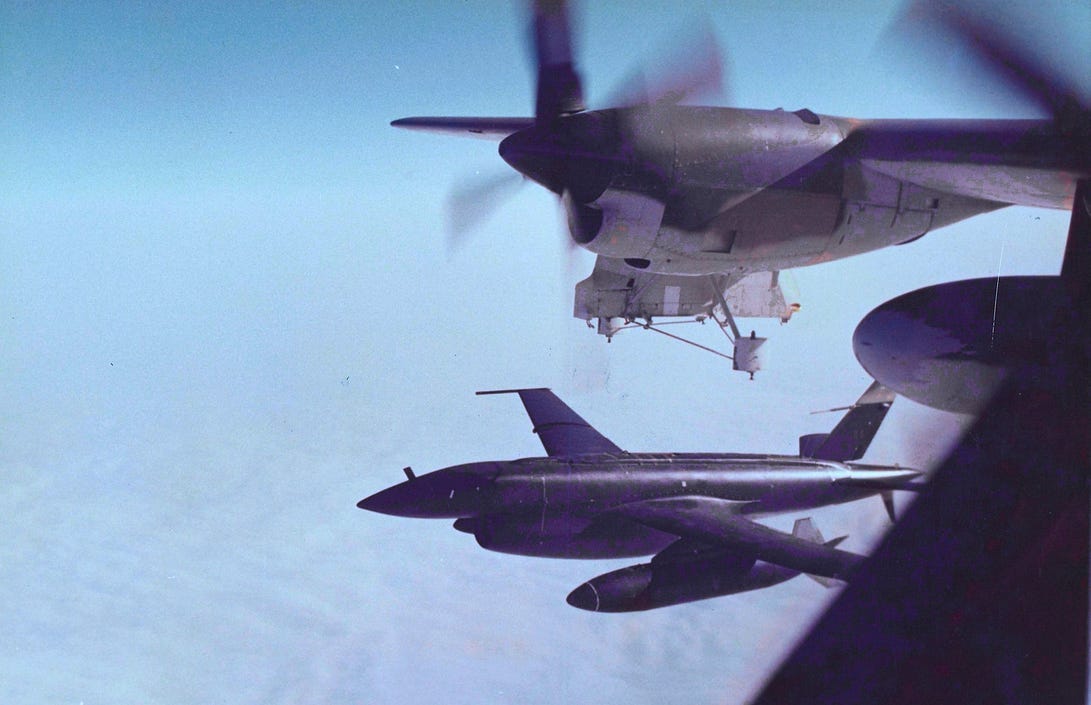American Drones ‘Shot Down’ Enemy Fighters Over North Vietnam
An excerpt from ‘Drone War: Vietnam’

On Dec. 17, 1965, U.S. president Lyndon Johnson met with his advisers in the White House. Johnson wanted to halt the air campaign over Southeast Asia in order to give diplomats a chance to work out some kind of peace agreement that might end the war.
Secretary of Defense Bob McNamara warned Johnson that the Joint Chiefs of Staff would oppose de-escalation. Johnson was insistent. “Try to sell our enemies that we want peace,” he said. “We owe this to the American people. We can’t do this if we are dropping bombs on the enemy.”
The bombing pause began on Dec. 24, 1965 and lasted until Jan. 30, 1966. The military halted raids by manned aircraft, but continued to send reconnaissance aircraft, including Lightning Bug drones, north into enemy territory.
The drones flew into a solid wall of enemy fire. Twenty-four missions resulted in the loss of 16 Model 147s, 10 of them new G-models. “Without the confusion of an accompanying air strike, the unmanned Ryan birds became very vulnerable north of the demilitarized zone and so the attrition rate went up sharply,” historian Bill Wagner explained.
SAC in a panic pleaded with Ryan Aeronautical to develop a decoy drone to fly along with the camera-equipped Lightning Bugs in order to draw away missiles and gunfire. Ryan Aeronautical said it could do it, no problem. The requirement was so urgent that the Air Force waived all normal acquisitions rules.
Ryan Aeronautical employee Dale Weaver paired up with Maj. Harold Smith, an Air Force maintenance officer at Davis-Monthan Air Force Base in Arizona, where much of the Lightning Bug development took place.
For two weeks in early 1966 Weaver and Smith scoured Air Force depots for equipment. They located 10 early-model Lightning Bugs and, enlisting airmen for “free” labor and over a period of ten days installed on the drones traveling wave tubes that boosted their radar signatures.
These Model 147N decoys arrived at Bien Hoa in March 1966. “The theory was to launch one of the high-altitude G or other operational birds almost simultaneously with an N decoy,” Ryan Aeronautical’s Bob Reichardt explained. “They would be programmed to fly parallel for a while and then diverge as they approached the target area.”
“They would be programmed to fly parallel for a while and then diverge as they approached the target area,” Reichardt added. “The split pattern would confuse the enemy’s ground radars, by giving them a choice of two birds at which to fire.”
The Lightning Bug team didn’t expect the Model 147Ns to return from their missions. There were no plans to recover them, so Ryan Aeronautical replaced the drones’ parachutes with sandbags. This resulted in a few farces on those rare missions where the decoy drones managed to avoid enemy fire. The decoys returned to Da Nang and circled until their fuel ran out.
But on most missions, the Model 147Ns did what Ryan Aeronautical designed them to do. They flew high, broadcasting a huge radar signature and drew fire from North Vietnamese air-defenders.
The Model 147Ns also managed to “shoot down” five North Vietnamese fighters, albeit indirectly, when the fighters ran out of fuel chasing the decoys. A North Vietnamese SAM battery accidentally shot down one MiG that was in hot pursuit of a drone. A MiG in similar fashion inadvertently shot down a second MiG that was tailing a Model 147N.
The 4080th Strategic Reconnaissance Wing expended all the Model 147Ns in the course of nine missions between March and June 1966. Strategic Air Command in August 1966 placed an order for 10 more decoys. The command hoped the new decoys might draw fire from its lumbering B-52s.

Ryan Aeronautical modified another batch of older Model 147s into Model 174NXs, this time adding a recovery parachute plus a simple camera with six-foot resolution. The camera on the recce Model 147s shot at a resolution of one foot.
That way, if a decoy did manage to survive its mission, it also could feed some film to the processing lab in Saigon. Who knew what kind of intelligence the Air Force might derive from it. “Trucks and things like that could be identified,” Wagner noted.
SAC headquarters wanted more low-altitude drones, but Ryan Aeronautical drone manager Bob Schwanhausser pushed back. “I didn’t think it was a very good idea,” he explained, citing the Model 147C’s abortive career. But SAC insisted. The command gave Ryan Aeronautical one day to draw up a proposal and one month to produce the first airframe.
Ryan Aeronautical decided to base the new, low-flying drone on the high-altitude Model 147G it already was producing. The first Model 147J was ready for testing in January 1966.
Aerodynamically, the J was a dog. Its big wing, a feature the J-model inherited from the G-model on which it was based, was more efficient at altitude.
One test flight over California on Jan. 3, 1966 nearly ended in disaster when the drone sharply pitched up shortly after launch and collided with the DC-130 mothership. The collision demolished the drone and knocked the propellers off the DC-130’s number-four engine.
The first three J-models all suffered catastrophic failures during trials. The fourth J worked as designed, however. It flew seven successful test flights before Ryan Aeronautical shipped it to Bien Hoa for operational missions.
Model 147J-4 flew five good missions in three months starting in March 1966.
In ramping up low-level flights with the Lightning Bugs, the team at Bien Hoa discovered a flaw in the drone’s systems, one that wasn’t evident or even problematic on high-level flights. Many of the low-level Lightning Bugs launched perfectly, successfully avoided getting shot up and even recovered without incident. But their missions still were failures.
Because, it turned out, they flew a course that was just a few miles to the left or right of a track that would bring them over the target. At high altitude, a few miles didn’t make any difference to a camera whose side-to-side field of view might be a hundred miles or more.
But at low altitude, the camera might see just a mile across. If the drone’s flight path deviated by a few miles, it might result in the vehicle photographing … nothing of interest. Trees. Villages. Rice paddies.
The problem actually started with the C-130 launch plane. The mothership’s Doppler radar as being accurate only to a few miles, meaning it was entirely possible the C-130 would be a few miles off-course when it launched its Lightning Bugs.
Meanwhile the drones’ own navigation systems were accurate only to around three percent of the distance the aircraft traveled from the launch point. After a few hundred miles, a Lightning Bug might be as far as 12 miles off-course. In that case, its film probably captured nothing useful.
Only a few of the low-level missions succeeded in capturing imagery of their intended targets.
The navigation inaccuracy was a fixture of the J-model low-level drones. But the J-models also helped to introduce major advancements in drone operations.
The Model 147J boasted two cameras instead of the one on earlier Lightning Bugs. Where older drones had just the front-to-back scanning camera, the J also featured a side-to-side camera.

The arrangement resulted in some remarkable photographs. On one mission, Model 147J-14 snapped a photo of a North Vietnamese surface-to-air missile barely missing the drone. The J’s low-level photos of ships in Haiphong Harbor were “unbelievable,” according to one Ryan Aeronautical employee.
The J’s excellent photography was no accident. It was the first Lightning Bug to carry two cameras. The standard, downward-looking Hycon HR233 camera with its 24-inch focal length plus a Fairchild KA-60 for side-to-side scans that captured the ground beneath the drone from horizon to horizon.
The KA-60 like all contemporary panoramic cameras was an engineering marvel. It managed to produce reasonably high-resolution, wide-angle photos with a lens that wasn’t wide. To accomplish this, Fairchild added a cylindrical prism in front of the lens. The prism rotated, compensating for the drone’s forward movement as the camera peered from side to side.
Granted, with its three-inch focal length and 4.5-by-9.4-inch format, the KA-60 was a lower-fidelity camera than the Hycon Model 233 was. But in photographing from horizon to horizon, it mitigated the navigational drift that plagued all low-level Lightning Bug missions.
Another advancement that coincided with the Model 147J’s arrival in South Vietnam resulted in a profound overall improvement in the Lightning Bugs’ usefulness.
On four of the initial Model 147J missions in the spring of 1966, the Air Force recovered the drone by way of its new “mid-air retrieval system,” or MARS.
MARS entailed a cargo plane or helicopter trailing a long hook to snag a payload while it was descending toward Earth under a parachute. The Air Force first deployed MARS, on the C-119 cargo plane, during tests of early Q-2 target drones in 1955.
Starting in 1959, the National Reconnaissance Office borrowed the method, equipping C-119s and C-130s to snatch film capsules from the earliest Corona spy satellites. The U.S. Army tinkered with a similar concept, but using helicopters instead of cargo planes.
But by 1965 the Army program was idle for a lack of funding. A Ryan Aeronautical employee named Fred Yochim heard a rumor about the Army effort and tracked down the captain who had flown the test-recoveries for the ground-combat branch at a base in New Mexico.
The captain happily handed over his records and equipment. Yochim showed it to the Air Force. “We got the program up and going,” Yochim recalled.
Modified for helicopters and drones, MARS worked like this. The drone deployed its recovery parachute at 15,000 feet over the recovery zone. The main ‘chute trailed a smaller ‘chute. For the MARS crew, the latter was the target.
Flying 3,000 feet below the drone as it popped its main ‘chute, the helicopter crew angled toward the secondary ‘chute, aiming to snag that ‘chute’s line with the grappling hook extending aft from the ‘copter’s belly.
After the helicopter grabbed the line, a mechanism on the main ‘chute collapsed the larger canopy. Now the drone was hanging more or less free from the helicopter. The ‘copter crew reeled in the drone until it trailed just 15 feet or so from the rotorcraft. The crew then flew the drone back to base and gently deposited it on the tarmac.
MARS radically improved the Lightning Bug program’s mission success rate. Where before there was a roughly even chance of a recovery failing or at least damaging the film — to say nothing of endangering the soldiers whose job it was to retrieve landed drones — with MARS missions that didn’t result in a shoot-down or a crash almost always ended in a successful recovery.
Between 1966 and the end of the Vietnam War, Army helicopters attempted 2,745 mid-air drone recoveries and completed 2,655 of them. A 96.7-percent success rate.




